Their project Island 2.0 was awarded the Multiplica Grant and selected for the cross-border residency organised by Rotondes, in partnership with the City of Metz and BLIIIDA, as part of the GRACE project under INTERREG IV Grande Région. Sandy Flinto, Pierrick Grobéty and Daniel Marinangeli are now delving into the history of Tuvalu, a small Pacific Island nation threatened by climate change. Determined to preserve its heritage and statehood, Tuvalu is exploring a unique path: digitally replicating and reconstructing itself in the metaverse. The island thus embodies the core themes that drive the collective’s work: ecology, culture, and technology. Ahead of their second week of residency at Rotondes, we caught up with the trio to learn more about their process and aspirations for the Island 2.0 project.

Eddi van Tsui “Our work seeks to present a variety of perspectives. It’s up to the audience to form their own.”
Co-funded by the European Union as part of the GRACE project — Interreg VI Grande Région
The proposal you submitted in response to the call for projects had a clear vision for Island 2.0. Does that mean the project had been in development for some time? At what point did your ideas converge on this specific concept?
S.F.: Before this, we undertook a seven-week preliminary research residency at the university, the Arche, and the Bridderhaus. It was called Terre d’origine and explored our relationship with land and technology through various lenses. During this period, Daniel discovered the story of the island of Tuvalu. By then, we had collected an array of diverse data. Following the research phase, we presented our findings publicly and to professionals at SPEKTRUM. The feedback revealed Tuvalu as a compelling focal point, touching on the ecological, social, economic, political, and identity-based themes that fascinate us. Thanks to this groundwork, we were well-prepared to respond to the call for projects.
So, Island 2.0 draws from the foundation of your previous work?
P.G.: Even if it hasn’t always been intentional, we’ve spent years building a substantial body of research on contemporary society to better understand its dynamics.
S.F.: Our process is consistently rooted in research and collaboration, whether we’re creating interdisciplinary pieces or installations. From the outset, Daniel brings his perspective as a playwright and author, Pierrick focuses on sound, and I develop the visual elements. In previous projects, we’ve explored themes like spatiality and migration, which often overlap. The theme always takes priority, and then we decide how best to translate it, whether through performance, video, or installation.
Why did you decide to use installation and sound performance for this project?
S.F.: Since the project explores the digitalisation of the world, incorporating digital tools felt like an obvious choice to me.
P.G.: In a previous project, I worked with modular musical instruments inspired by computing. I connected simple functions with physical cables to create complex systems. I decided to reuse that setup for Island 2.0, though I’m still experimenting with it. This is also the first time I’ll combine all three approaches I use in instrument-making: acoustic, computational (managing sound), and electronic (generating sound with electricity).
(photo: Nathan Roux)
How did your first week of residency in December unfold?
D.M.: It was mainly focused on research. We gathered texts, documentaries, news reports, and images related to Tuvalu. We also investigated the technological aspects of replicating the island in the metaverse.
S.F.: One of our primary focuses was understanding why Tuvalu chose this path. While the metaverse project doubles as a fundraising initiative, its core motivation is legal: a country cannot exist without a physical territory. With Tuvalu facing the reality of disappearing, Australia has offered its residents asylum – but with conditions attached.
P.G.: Part of Australia’s offer involves a demand for territorial rights, including control over fishing zones and seabed resources.
S.F.: Tuvalu’s story ties into another theme central to our work: ecology. Maintaining the metaverse is highly polluting. There’s an unsettling irony in trying to save an island sinking due to climate change by using a technology that contributes to it.
D.M.: Perspective is also key. Tuvalu’s efforts to connect with the global community often contrast with the way it’s perceived through a Western lens. It evokes flood-as-punishment narratives like the Deluge or Atlantis.
S.F.: To sum up, we’ve compiled visual material, edited it, and selected key excerpts. Although we considered creating original video content, the research phase has taken precedence for now.
What are your goals for the second residency week in February?
S.F.: Our main focus will be on preparing for the showcase at Multiplica Lab. We’re planning to feature a large screen placed on the floor to create an abstract and immersive sensory experience. This will be paired with a smaller monitor and headphones where visitors can listen to migration stories.
Do you see the upcoming showcase as a constraint or an opportunity?
S.F.: It’s inspiring to know that the showcase fits within the wider context of Multiplica Lab – it gives our work added meaning.
P.G.: Although defining a format can be mentally taxing, it also allows us to experiment with how screens and speakers are arranged. The goal is to create an interactive setup that prompts visitors to move and experience the work in new ways.
D.M.: It’s also an opportunity to gauge audience reactions: what resonates with them and what doesn’t. An external perspective is always helpful.
S.F.: People are generally curious and open to discussion. They ask questions, and because we have so many potential answers to offer, it often sparks even more thought and reflection on their part.
P.G.: Ultimately, our artistic goal is to present a variety of perspectives. It’s up to the audience to interpret and draw their own conclusions.






